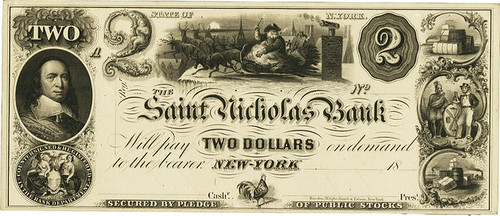
PREV ARTICLE
NEXT ARTICLE
FULL ISSUE
PREV FULL ISSUE
THE SAINT NICHOLAS BANK
David Sundman forwarded thie Bloomberg View article "When Santa Was a Bank" about the Saint Nicholas Bank of New York.
Thanks! -Editor

It’s bonus season, and while many in the junk bond market should expect coal in their stocking, the rest of Wall Street remains hopeful that Santa Claus remembers them this year. Given the Fed’s rate hike, though, more than a few financiers are losing faith. It would help, perhaps, if Wall Street had a direct line to Santa Claus. Once upon a time, it did. For much of the 19th century, Santa Claus had a branch office at No. 12 Wall Street. This was the “Saint Nicholas Bank,” established in 1853 and capitalized at $500,000. The origins of the Saint Nicholas Bank are a bit murky. Aside from the fact that it built a safe that Bankers’ Magazine described in 1854 as “the largest in the United States, if not the world,” the new institution attracted very little notice. At this time, state-chartered banks in the United States issued their own currency, in denominations and designs of their choice. This system of private money creation flourished before the Civil War, with nearly 2,000 banks printing their own currency by the end of the 1850s. The Saint Nicholas Bank printed money illustrated with – who else? – Santa Claus. The $1 and $3 bills showed Santa popping out of the fireplace to tend to children’s stockings. The big man was depicted in various poses in his reindeer-drawn sleigh on the $2, $5, and $10. The $20 and $50 showed the jolly old elf popping out of another fireplace, with sleeping children tucked into a bed a few feet away. (The rarely seen $100 note, by contrast, showed the U.S. Capitol building – so much for holiday cheer). Still, why would Santa Claus adorn a bank note? The answer lies with the deeper history of New York City business and finance, and possibly, the man who would loom the largest over the bank’s reputation. By the 1830s, New York City had become the capital of the Santa story that rested on a largely fabricated genealogy that paid homage to the city’s Dutch founders. Credulous readers learned that the first church in New York City was named for Saint Nicholas, and that the first Dutch ship to land had a figurehead of Saint Nicholas. All of this made a certain amount of sense. A city founded on mercantile wealth and maritime trade would look toward St. Nicholas for protection of valuable cargoes. Indeed, it would be no exaggeration to say that St. Nicholas had become an informal patron saint of New York by the 1830s. The notes of the Saint Nicholas Bank combine all of these elements. In addition to Santa Claus himself, several of the notes depict ships and the docks of New York; others show New Amsterdam’s famed governor, Peter Stuyvesant. Likewise, some of the buildings shown on the notes as a backdrop to Santa’s sleigh have the crow-stepped gables characteristic of Dutch architecture. The people who founded the Saint Nicholas Bank are less well known. After a couple of years of high turnover, one man in particular stands out: a prominent New York merchant named Caleb Barstow, who became president in 1856 and remained in the position until 1874. In an obituary from 1880, Bankers’ Magazine reported that his “deeds of charity were many and unostentatious” – strange behavior, perhaps, for a Gilded Age banker. Indeed, in its obituary, the New York Herald described him as “in some respects a very peculiar man,” even as it praised him for his “generous nature.” In fact, it seems that Barstow took to heart the ethos of St. Nick, believing it better to give than to receive. He contributed heavily to charities and handed out food and clothing to the poor. And though he accumulated a large fortune in his lifetime, he died penniless. Not long afterward his bank perished, too. A few days before Christmas in 1893, the State of New York declared the Saint Nicholas Bank insolvent. It closed its doors, never to reopen. In the canyons of Wall Street, a vision of Santa lingers. He's dressed in a business suit, a bundle of bonuses flung on his back. To read the complete article, see:

Wayne Homren, Editor The Numismatic Bibliomania Society is a non-profit organization promoting numismatic literature. See our web site at coinbooks.org. To submit items for publication in The E-Sylum, write to the Editor at this address: whomren@gmail.com To subscribe go to: https://my.binhost.com/lists/listinfo/esylum All Rights Reserved. NBS Home Page Contact the NBS webmaster 
|